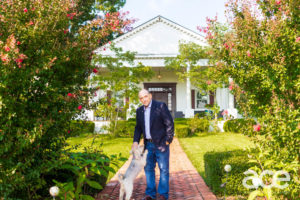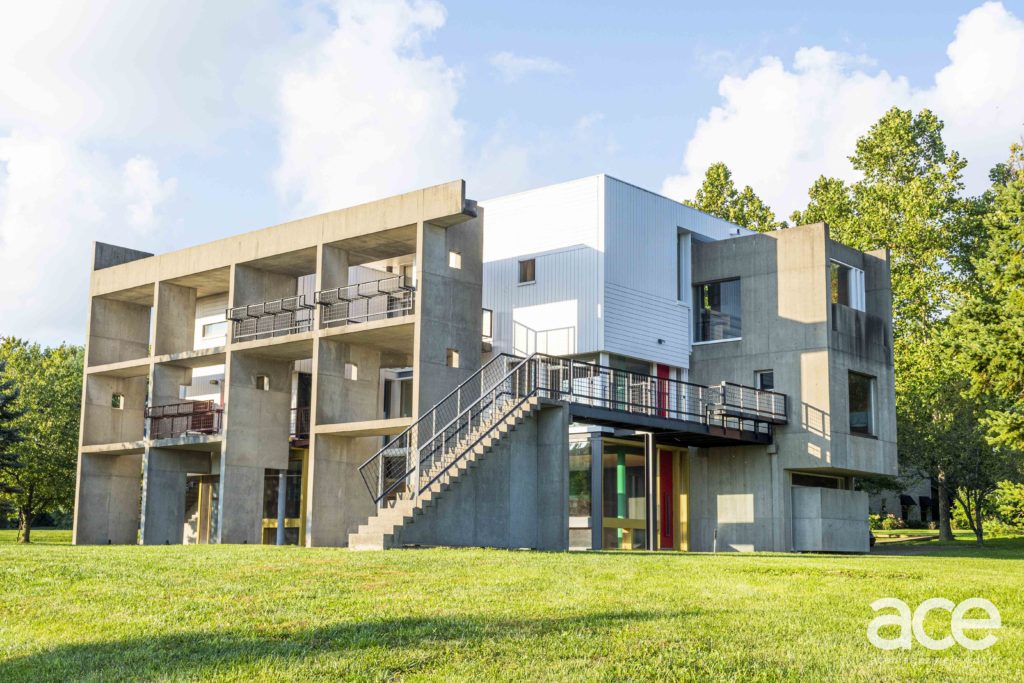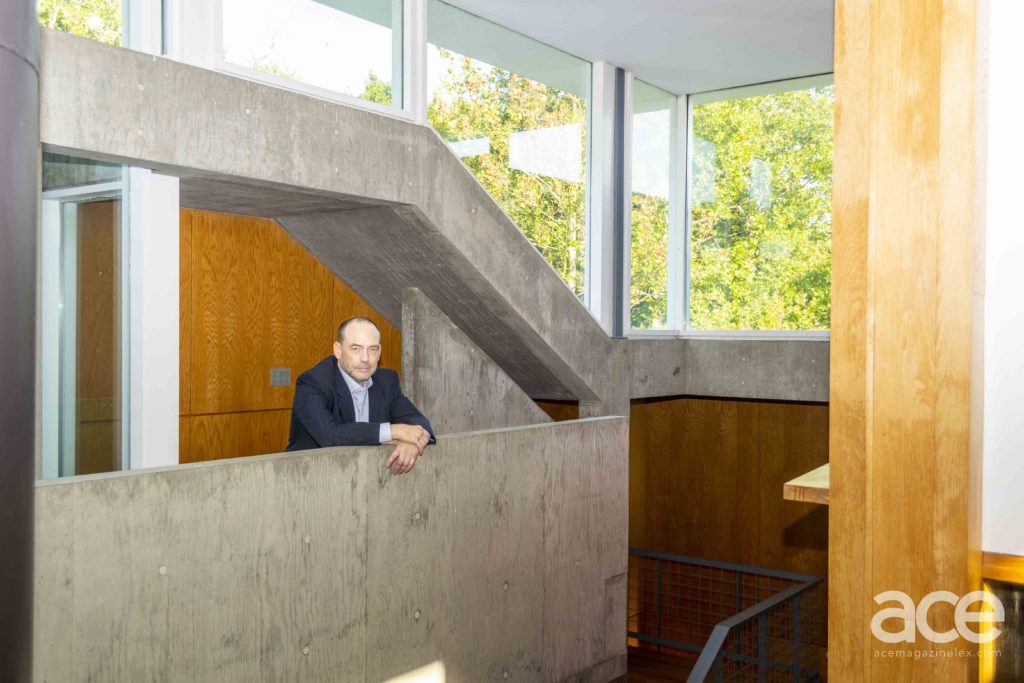
Fixer Upper
What will Stephen Taylor fix next?
By Kevin Nance
Soon after Stephen Taylor Jr.’s family moved from Florida to Rowan County in the mid-1970s, his father, a professor of education and later a vice president at Morehead State University, bought a farm in West Virginia that included a ramshackle old house covered with weatherboarding. The elder Taylor’s initial thought was to tear down the house, perhaps just burn it to the ground. But when he began to pull off the siding, he found a vintage log cabin underneath. Instead of demolishing it, he decided to restore it. And for the next three years, the family would drive every weekend from Morehead to Pennsboro, WV — 212 miles each way — to work on the cabin.

“He had to jack it up, put in a new foundation, re-chink all the logs with cement,” recalls Taylor, now 54. “As a little kid, eight or nine years old, I couldn’t do a whole lot, but I could run around and burn things or clean things or pick things up.” He smiles at the memory. “At the time, I may have dreaded some of those trips, and was happy to get back to Morehead. But it did give me an appreciation for old houses and the need to preserve them.”
Nearly half a century later, Taylor is still preserving houses. While maintaining his day job as a financier — he manages the Taylor International Fund, an investment firm specializing in turning around small companies in trouble — the Princeton graduate has devoted much of his time over the past 25 years to buying and restoring historic, often dilapidated homes, including several 1920s-era Spanish-style houses in Los Angeles, where he lived until moving back to Kentucky in 2019 to be near his elderly parents.
“As a little kid, eight or nine years old, I couldn’t do a whole lot, but I could run around and burn things or clean things or pick things up…It did give me an appreciation for old houses and the need to preserve them.”
—Stephen Taylor Jr. recalls childhood memories of his dad’s vintage cabin restoration project

Taylor now lives and works in the famous farmhouse on the 42-acre estate he purchased a few years back, once occupied by the mother of movie star Johnny Depp on Versailles Road in Lexington. (Coincidentally, he once met the actor while the two of them were on their knees on the floor of Depp’s Hollywood nightclub, the Viper Room, looking for a friend’s lost contact lens. “He was nice,” Taylor says.)
About “Betty Sue’s Family Farm”
Kentucky native Johnny Depp first picked up the iconic Versailles Road farm in 1995 for $950,000, sold it in 2001 for $1 million, and then bought it back in 2005 for $2 million. Depp’s mother, Betty Sue Palmer, lived at the property until her death in 2016.
Guy Martin wrote about the estate in Forbes Magazine in October of 2018, when the listing attracted national attention during that year’s Breeders’ Cup, held at Churchill Downs. “During a Breeders’ Cup week, it sometimes pays to take a glance at the local real estate, especially when, as this year, the race is staged in Kentucky. Betty Sue’s Family Farm, as Johnny Depp’s mother’s place is called, includes forty-two acres, stable capacity for a dozen horses, and could hardly be located any closer to the beating heart of American Thoroughbred breeding and racing. The six-bedroom, six-bath neo-colonial ranch, with a four-columned portico fronting its 6600 square feet, lies two miles west of Keeneland race course on Versailles Road, which is to say, smack in between the site of the Keeneland Thoroughbred Sales and the central Bluegrass clutch of the world’s winning-est breeding farms.”
Current owner Stephen Taylor still refers to it as “Betty Sue’s Family Farm,” as do most of the neighbors.
—staff
Now he’s taken on perhaps the most high-profile preservation project of his life. In May, Taylor won a foreclosure auction (with a bid of $800,000) of the Miller House, a modernist architectural marvel in southeastern Lexington designed in the late 1960s by José Oubrerie, a former dean of the University of Kentucky College of Design and a protégé of the famous French architect Le Corbusier. While not a fixer-upper like the Los Angeles houses — although it does have some rainwater drainage issues that Taylor is addressing — the Miller House has been considered an endangered property because of its lack of historic designation and protection and its awkward position as the only structure of its kind in Lochmere Place, a large subdivision with dozens of traditional homes on small lots. At 5,000 square feet above ground, the Miller House is also considerably larger than most of the homes that surround it on all sides, which further accentuates its startling difference from its neighbors.
And if the three-story glass-and-concrete exterior — views of which shift “like a Rubik’s cube,” Taylor says, depending on where you stand — is notably out of sync with the overall design ethos of the area, the interior is even more so. “It has lots of nooks and crannies,” Taylor points out, with considerable understatement, during a recent tour of the home. Oubrerie’s design leads the visitor through the labyrinth of rooms along a winding path of gleaming wood stairways, metal railings and concrete slabs that connect in a way that recalls the mind-bending visions of the Dutch graphic artist M.C. Escher. Many rooms open onto interior landings that overlook a central atrium-like space and abstract fireplace on the ground floor; others have outward-looking balconies, a few of which lead to jutting, gangplank-like decks.
“There are 14 doors leading to the outside,” says Michele Nolan, a Taylor staff member who is currently living in the house as a temporary caretaker. “I counted.” Most of those doors, along with the ones on the interior, have operable doors and/or windows within them, allowing for ventilation and/or peeking into the adjacent spaces. Almost every room is equipped with some fascinating built-in feature — a cabinet here, shelves there, often so hidden that a visitor has to spend considerable time just to spot them. The Miller House would be an excellent place for a treasure hunt.

“We love the idea of using [the Miller House] not just as a museum, but as a working facility for our preservation faculty and for research for the students. We’re just beginning to explore those ideas with Steve, who would love it if the house could be useful to us.”
—Mitzi Vernon, Dean of UK’s College of Design
Or perhaps an outpost for an architecture school. Although Taylor hasn’t ruled out living and working in the Miller House himself — “It might be a bit big for just one person,” he says, “but I can envision it” — it’s more likely that the house will become an auxiliary space for UK’s College of Design, with which he’s developing a relationship. He’s in early discussions with Mitzi Vernon, the college’s current dean, about making the house available to UK as a place for lectures, offices, meeting rooms and/or a residence for visiting scholars.
About the Miller House
Lexington’s historic José Oubrerie’s Miller House, located off Chilesburg Road in Lochmere, was auctioned in late May of this year. Curbed described it in 2016 as “an under-recognized building that traces its lineage back to one of Modernism’s godfathers, Le Corbusier. Designed by his associate José Oubrerie, who was then the dean of architecture at University of Kentucky, the home takes Corbusian principles and modern design philosophies and amplifies them… But in both its locations and construction, it’s a building out of time. Finished in 1992, it’s a Modernist statement that may have come a few decades late.”
It was on and off the market for years, with multiple preservationist efforts to save it, before Stephen Taylor Jr.’s winning auction bid of $800,000.00 in May.
—staff
“We were delighted that Steve was interested in this house and that he wants to preserve it,” says Vernon, who notes that she tried to convince university officials to buy it when it came on the market in 2017; that plan fell through because the College of Design would have had to pay for the off-campus property’s maintenance. “We love the idea of using it not just as a museum, but as a working facility for our preservation faculty and for research for the students. We’re just beginning to explore those ideas with Steve, who would love it if the house could be useful to us.”
For Taylor, that prospect would be just the latest chapter in a lifetime of preservation work that began so long ago with that log cabin in West Virginia. And he’s not done yet.
What’s next?
He recently purchased the 256-acre farm next door to the former Depp estate and is considering what to do with the main house and a smaller home in the back of the property. (In the short term, he says, he may raise cattle on that farm, its main function in recent decades.) He also has a hankering to get involved in some other real-estate ventures in Lexington — perhaps including the Kentucky Theatre, where he has seen many movies over the years.
“I’ve got a soft spot for movie theaters,” he says. “And the Kentucky, especially, is part of helping Lexington’s city-center traffic and nightlife, and I just hate to see it closed. I’d be happy to fund a portion of the operating expenses of that theater, or a portion of the losses, if that would help it reopen.”
Stay tuned.

This article also appears on page 10 & 11 of the October 2021 print edition of Ace.
Subscribe to the Ace e-dition for Lexington news, arts, culture, food, and entertainment news delivered to your inbox.
Call today to advertise in Ace, 859.225.4889









